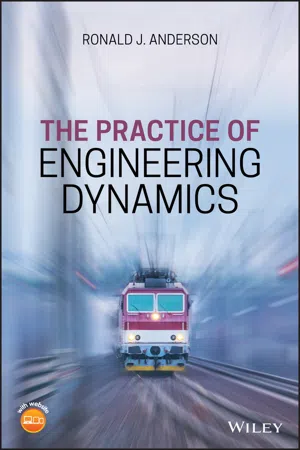
- English
- ePUB (mobile friendly)
- Available on iOS & Android
The Practice of Engineering Dynamics
About this book
The Practice of Engineering Dynamics is a textbook that takes a systematic approach to understanding dynamic analysis of mechanical systems. It comprehensively covers dynamic analysis of systems from equilibrium states to non-linear simulations and presents frequency analysis of experimental data. It divides the practice of engineering dynamics into three parts: Part 1 - Modelling: Deriving Equations of Motion; Part 2 - Simulation: Using the Equations of Motion; and Part 3- Experimental Frequency Domain Analysis. This approach fulfils the need to be able to derive the equations governing the motion of a system, to then use the equations to provide useful design information, and finally to be able to analyze experimental data measured on dynamic systems.
The Practice of Engineering Dynamics includes end of chapter exercises and is accompanied by a website hosting a solutions manual.
Frequently asked questions
- Essential is ideal for learners and professionals who enjoy exploring a wide range of subjects. Access the Essential Library with 800,000+ trusted titles and best-sellers across business, personal growth, and the humanities. Includes unlimited reading time and Standard Read Aloud voice.
- Complete: Perfect for advanced learners and researchers needing full, unrestricted access. Unlock 1.4M+ books across hundreds of subjects, including academic and specialized titles. The Complete Plan also includes advanced features like Premium Read Aloud and Research Assistant.
Please note we cannot support devices running on iOS 13 and Android 7 or earlier. Learn more about using the app.
Information
Part I
Modeling: Deriving Equations of Motion
1
Kinematics
1.1 Derivatives of Vectors

- The rate of change of magnitude .

- The rate of change of direction .











Table of contents
- Cover
- Table of Contents
- Preface
- About the Companion Website
- Part I: Modeling: Deriving Equations of Motion
- Part II: Simulation: Using the Equations of Motion
- Part III: Working with Experimental Data
- A Representative Dynamic Systems
- B Moments and Products of Inertia
- C Dimensions and Units
- D Least Squares Curve Fitting
- Index
- End User License Agreement